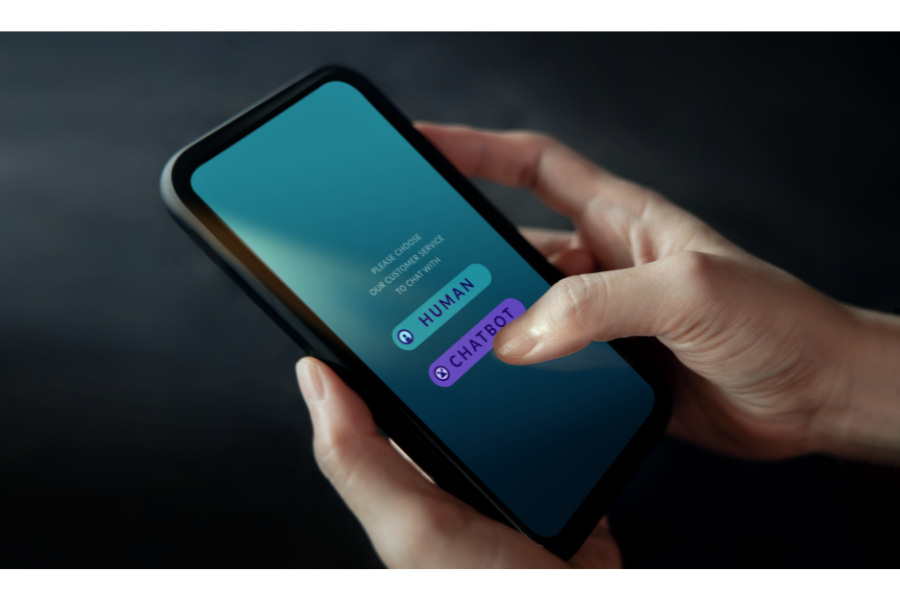I. Introduction
Chatbots powered by artificial intelligence have advanced incredibly in recent years, providing efficient and cost-effective customer support. However, nothing beats the human touch of a live service agent for providing empathy, personality, and complex problem-solving. How do businesses balance utilizing the best features of bots and humans?
This definitive guide examines the pros and cons of chatbot vs human representatives for delivering optimal customer service. Discover when A.I. chatbots excel and where the human touch still reigns supreme. Learn strategies for successfully implementing chatbots while retaining human agents for specialized needs. Get insights into the future of A.I. and how bots and humans can work together to create the ultimate customer experience.
II. Chatbots Skills vs. The Human Abilities Behind Live Chat

According to Forrester, 45% of online shoppers in the U.S. will abandon their purchase if they can’t find an immediate answer to their questions about a business’s products and services. As such, most companies nowadays have a method of constantly communicating with their customers. This is true regardless of whether they operate online or from brick-and-mortar stores. These methods are often narrowed down to two tools: chatbots or live chat.
In this eGuide, we'll learn more about the merits of chatbots and live chat ,as well as which is the superior tool.
Chatbots
Based on an article by Business Insider India, 66% of U.S. consumers take advantage of chatbots whenever they have an inquiry with a business. After all, they’re often quick to respond, offer a personalized experience, and are even available 24/7. Chatbots are an excellent asset to have to keep customer engagement. This is especially true if a business caters to clients around the world.
However, like any piece of technology, chatbots do have their limitations as well. For instance, the main limitation that both customers and businesses are worried about is that, depending on their programming, chatbots can be limited in their responses. As a result, if a customer has more complex questions, the chatbot will be unable to give them a proper answer. This leads to the so-called “Chatbot Loop” and would result in the customer becoming frustrated enough to refuse a business’s services.
Another limitation of chatbot vs live chat is that chatbots are high maintenance. Remember, a chatbot is a program, so someone will have to program it correctly to answer client questions. However, as your business’s products and services evolve, you must also analyze the common questions customers ask and reprogram the chatbot to accommodate these changes.
Reprogramming your chatbot can provide customers with updated information should they need it. This reprogramming process can consume a significant amount of time that an agent can use to quickly answer it instead. Additionally, if the person doing the reprogramming is not careful, it could cause the chatbot to briefly stop working, causing inconvenience to your customers.
The final limitation that chatbots suffer from is that they lack the human touch. Customer service isn’t just about answering customer inquiries and concerns. Understanding the customer’s emotions and showing empathy when needed is another important aspect of the profession. Providing a human touch is where live chat software comes out on top.
Without the emotional understanding that only humans can provide, a frustrated customer can abandon availing a business’s products and services. As a result, the tool that was supposed to help a company assist customers and improve profits can cause it to lose business and profit instead.
Live Chat
Live chat is another customer service tool that businesses use. In fact, it's a tool that’s beginning to garner quite the following among online customers. Based on an article by Forbes, a study has found that around 86% of consumers prefer chatting with a human over chatbots when they have questions about a product or service. The same study also said that 71% of customers would be less likely to do business with a brand if there weren’t any available human representatives.
But why exactly is live chat a popular customer service tool?
One reason for live chat's popularity is that it can increase a business’s reach and availability. After all, live chats aren’t just available 24/7; the agents behind them can also be multilingual. Companies can also have an auto-translate feature programmed into the live chat widget. This allows businesses to assist any customer who may need it, providing a seamless customer service experience.
Another reason some businesses are shifting to live chat support is that customer service efforts run smoother when they're implemented. According to Hubspot, 90% of customers expect an immediate response when they have questions. Live chat allows businesses to respond quickly to their customers compared to chatbots. They can even provide answers to the more complex questions that chatbots would normally have a hard time providing an answer to.
Apart from that, live chat can also resolve customer problems faster. This is because there’s an actual person trained to assist customers in real time in various ways. These methods include screen-sharing and co-browsing. With the quick response time and fast problem resolution that live chat provides, customer satisfaction can be significantly increased.
Finally, live chat often wins the chatbot vs human representative discussion because they have the human touch that chatbots lack. Trained agents operate live chats and can often provide better customer service than chatbots. According to a 2022 Forbes article, 58% of customers are more than willing to pay for better customer service. This makes live chats a great asset to have simply for this reason.
Simply put, with live chat, clients can communicate with a customer service representative who empathizes with their plight, emotions, and needs.
Human representatives - 1, Chatbots - 0
III. Cost and Scalability Benefits of Chatbots

Despite the flaws of chatbots, it does have another benefit that makes it an attractive tool for businesses: cost and scalability. If implemented and utilized correctly, chatbots can bring significant cost benefits for businesses. For instance, using chatbots as a customer service tool can reduce business costs.
Based on Zendesk’s CX Trends Report, 68% of professionals believe that chatbots can drive up business savings in the coming years. The reason for this is unlike live chat, chatbots are entirely run by artificial intelligence. This, in turn, eliminates the need for a person to assist customers in their needs.
While implementing a chatbot into a website can be costly, it should be noted that this is a one-time investment that can pay off in the long run. Once installed, businesses only need to maintain and update chatbots periodically. This starkly contrasts live chat representatives who require a monthly salary. Training costs and overtime pay for after-hours staffing are other expenditures that can be removed through the use of chatbots.
By removing these expenditures, businesses can save a significant amount of their profit and use it to improve the company in other ways.
Scalability is another benefit of chatbot vs live chat. Live chat agents can only respond to a set amount of people at any given time. In fact, the number of customers they can respond to might even be lower depending on the complexity of each customer’s problems.
With chatbots, website owners won't have to worry about low numbers of assisted customers. After all, chatbots can easily handle large volumes of interactions. Depending on the client's demands, they can even be scaled up or down.
Through chatbots’ scalability, businesses can cater to the needs of as many clients as needed. As a result, customer satisfaction is significantly increased, improving a business’s conversion rates in the process.
Human representatives - 1, Chatbots - 1
IV. Human Emotional Intelligence: Why They’re Important in Customer Service

Nowadays, business websites turn to technologies such as chatbots to improve customer satisfaction and business efficiency. At the same time, they’re also doing this in hopes of cutting labor costs. Unfortunately, as stated in an article by the Wall Street Journal, this excessive dependence on technology resulted in the decline of customer experience quality by 71.3%.
Because of the lack of satisfaction, website visitors will likely air their frustrations out online. By doing so, they’re hoping that the company they’re doing business with will take their complaints seriously. This is especially true now that companies rely increasingly on emotionless chatbots to handle customer complaints.
As a result, human emotional intelligence in customer service is valued now more than ever. Here are a few reasons why such a quality is still sought after when assisting customers:
- It Increases Sales and Creates Loyal Customers - According to a study by NewVoiceMedia, 86% of customers say that a positive connection with a representative would prompt them to avail of a business’s products or services again. This study proves that a highly emotional intelligence representative allows companies to build rapport with their clients through a genuine emotional connection. This rapport not only helps businesses increase sales but also creates loyal customers.
- It Increases Employee Productivity - Businesses can expect employee productivity to increase if customer service representatives have a high emotional intelligence. This is because emotionally intelligent employees are great at empathy and listening to customers. As a result, they can get a feel for the customer’s plight, resolving issues and answering questions faster in the process.
- It Makes Communication More Effective - A customer service agent with high emotional intelligence is more skilled at effective communication than chatbots. Compared to chatbots, emotionally intelligent representatives can recognize customers' emotions and adapt their approach accordingly. By doing so, communication flows more smoothly and effectively. This allows representatives to get to the root of the customer’s problem faster.
Human representatives - 2, Chatbots - 1
V. Common Customer Service Problems That Require a Human Touch

As tools that are operated by A.I., chatbots can be an efficient tool for answering customer queries. However, because of their limitations, their assistance can only go so far. In addition, their lack of emotional understanding toward the customer’s plight can be off-putting and sometimes frustrating on the client’s part. According to a survey by Zippia, 72% of customers are more likely to switch brands after having a bad experience with one.
When working in customer service, there are a few common problems that actual humans best handle. That way, these problems can be resolved faster but also in a manner that empathizes with the customer’s current emotions.
- Unavailable Products
Products running out of stock is a good sign for a business. However, if the product stays out of stock for too long, the customer can be frustrated and move to a different company that has what they need.
This is where human representatives come in. Often, chatbots cannot assist clients beyond telling them that an item is out of stock. An agent can offer to help customers in creating a special order to get the product that they need. If this solution isn’t possible, representatives can offer to notify clients when the item is back in stock instead.
By doing so, businesses can show that they’re aware of the customer’s plight, providing them with a quality customer service experience in the process.
- Poor Product Quality
Sometimes, a product can break on its way to the client or suddenly stop working as intended after a few days. Sometimes, it may not even be defective at all but the customer needs assistance to get it to work correctly. Should any of these scenarios occur, it can be expected that customers will complain and demand action from the company. These actions include immediate assistance, replacements, or even an outright refund.
When discussing chatbot vs live chat, this is one of the delicate situations that should not be left to the former. Most likely, the customer is already frustrated and barebones assistance from emotionless chatbots will only frustrate them further. As such, the service of an actual representative will be vital here. They’ll be able to empathize with the customer’s frustration and offer a variety of ways to make it up to them, such as a free replacement or an offer of a better product.
By showing that your staff understands the customer’s frustration and offering immediate solutions, you show that you value them as clients. This will do wonders in preventing customers from turning to the competition to have their needs fulfilled.
- Lack of Follow-up from Business
When a customer requires a replacement product or they’re waiting for the product to come back in stock, they’re expected to want a follow-up from the business they’re dealing with. Unfortunately, this is where chatbots fall flat once again as chatbots don’t send follow-ups to customers. As a result, the lack of progress may frustrate the client. They may even think that the business has forgotten their request.
Customer service agents, meanwhile, can quickly satisfy their customers in this aspect. By taking a proactive approach, they can establish a system with the client that ensures they’re updated on the progress of their request now and then. That way, they’ll be more patient in receiving a resolution.
Additionally, by giving occasional updates, the customer will feel that the company they’re doing business with values their time and needs.
Human representatives - 3, Chatbots - 1
VI. How Chatbots and Humans Can Work Together to Serve Customers

Usually, in the chatbot vs human representative debate, both tools are often pitted and compared against one another. Some would claim that chatbots are the better customer service tool. Meanwhile, others would say nothing beats the human touch that customer service agents provide.
But what if comparing the two tools is unnecessary? What if businesses can make chatbots and human representatives work together to serve clients better?
Chatbots and customer service agents can work together in a variety of ways. For instance, implementing this hybrid solution makes a business’s customer service available 24/7, even with a primarily human staff.
With this setup, human representatives can assist customers during the daytime while chatbots can help them after hours. As a result, customers are catered to no matter what time of day it is. This is a great advantage for every business, especially those with clients worldwide.
Apart from making customer service available 24/7, chatbots can also aid agents in improving the way they assist clients. Remember, most of the time, chatbots can only answer simple inquiries, leaving the complex questions for the actual representatives to handle.
Through the use of chatbots, representatives can check the conversation records between the client and the chatbot to see the customer journey for themselves. By doing so, agents can quickly resolve the problem that the chatbot couldn’t solve.
VII. How A.I. Can Further Revolutionize Customer Service

With the advancement of A.I. technologies such as chatbots, plenty of businesses are turning to them to cater to their clients. After all, A.I. has already helped improve the way we do customer service through instant responses, 24/7 availability, multiple language support, and even personalization.
However, believe it or not, A.I. can still take things a step further. This is because A.I. tools like chatbots are expected to have improved machine learning capabilities soon.
With machine learning capabilities, A.I. tools will be able to gather data and experiences that will allow them to be quicker in understanding the client’s needs. This would enable them to provide even more accurate solutions to clients. It can even help the agents assist customers in the process.
Additionally, A.I. will also revolutionize customer service as more and more tools implement predictive analytics into their programming to determine future customer behavior and needs. In doing so, chatbots and customer service agents alike will be able to take a proactive approach when addressing client issues. With such a feature, clients can enjoy a more satisfying customer experience whenever they need assistance.
VIII. Conclusion
As consumers continue to move to the online landscape for their needs, improved customer service will be needed more than ever. While chatbots are reliable as customer service tools, nothing beats the human touch you can get with the agents that work with live chat or even live video chat. So, what is the best solution for answering the chatbot vs human representative dilemma? The answer is a hybrid solution.
By having technology like chatbots work hand-in-hand with customer service agents, businesses can quickly adapt to each customer's ever-changing wants and needs. In turn, companies will be able to refine the way they support their clients constantly.
As a result of this stellar customer service reputation, immense trust and lasting connections with customers will be built, driving conversions in the process regardless of the competition.
